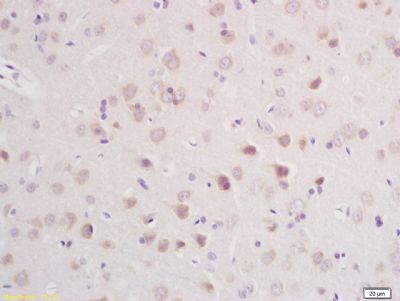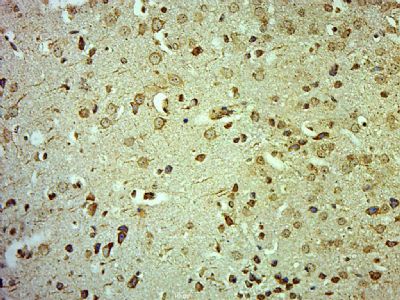CLCN3 Polyclonal Antibody
Purified Rabbit Polyclonal Antibody (Pab)
- 产品详情
- 实验流程
Application
| WB, IHC-P, IHC-F, IF, E |
|---|---|
| Primary Accession | P51790 |
| Reactivity | Rat, Pig, Dog, Bovine |
| Host | Rabbit |
| Clonality | Polyclonal |
| Calculated MW | 90966 Da |
| Physical State | Liquid |
| Immunogen | KLH conjugated synthetic peptide derived from human CLCN3/CLC-3 |
| Epitope Specificity | 81-180/818 |
| Isotype | IgG |
| Purity | affinity purified by Protein A |
| Buffer | 0.01M TBS (pH7.4) with 1% BSA, 0.02% Proclin300 and 50% Glycerol. |
| SUBCELLULAR LOCATION | Isoform 1: Membrane; Multi-pass membrane protein. Early endosome membrane; Multi-pass membrane protein. Late endosome membrane; Multi-pass membrane protein. Cytoplasmic vesicle, secretory vesicle membrane; Multi-pass membrane protein. Isoform 2: Membrane; Multi-pass membrane protein. Early endosome membrane; Multi-pass membrane protein. Late endosome membrane; Multi-pass membrane protein. Golgi apparatus membrane; Multi-pass membrane protein. |
| SIMILARITY | Belongs to the chloride channel (TC 2.A.49) family. ClC-3/CLCN3 subfamily.Contains 2 CBS domains. |
| SUBUNIT | Homo- or heterodimer. Isoform 2 interacts with GOPC, PDZK1 and SLC9A3R1/EBP50. |
| Post-translational modifications | N-glycosylated. |
| Important Note | This product as supplied is intended for research use only, not for use in human, therapeutic or diagnostic applications. |
| Background Descriptions | Mediates the exchange of chloride ions against protons. Functions as antiporter and contributes to the acidification of the endosome and synaptic vesicle lumen, and may thereby affect vesicle trafficking and exocytosis. May play an important role in neuronal cell function through regulation of membrane excitability by protein kinase C. It could help neuronal cells to establish short-term memory. |
| Gene ID | 1182 |
|---|---|
| Other Names | H(+)/Cl(-) exchange transporter 3, Chloride channel protein 3, ClC-3, Chloride transporter ClC-3, CLCN3 |
| Target/Specificity | Expressed primarily in tissues derived from neuroectoderm. Within the brain, its expression is particularly evident in the hippocampus, olfactory cortex, and olfactory bulb. Highly expressed in aortic and coronary vascular smooth muscle cells, and aortic endothelial cells. Also expressed in tracheal and alveolar epithelial cells, and intima and media of the pulmonary vessels. Expressed in bronchus and colon (at protein level). |
| Dilution | WB=1:500-2000,IHC-P=1:100-500,IHC-F=1:100-500,IF=1:50-200,ELISA=1:5000-10000 |
| Format | 0.01M TBS(pH7.4) with 1% BSA, 0.09% (W/V) sodium azide and 50% Glyce |
| Storage | Store at -20 °C for one year. Avoid repeated freeze/thaw cycles. When reconstituted in sterile pH 7.4 0.01M PBS or diluent of antibody the antibody is stable for at least two weeks at 2-4 °C. |
| Name | CLCN3 |
|---|---|
| Function | [Isoform 1]: Strongly outwardly rectifying, electrogenic H(+)/Cl(-)exchanger which mediates the exchange of chloride ions against protons (By similarity). The CLC channel family contains both chloride channels and proton-coupled anion transporters that exchange chloride or another anion for protons (PubMed:29845874). The presence of conserved gating glutamate residues is typical for family members that function as antiporters (PubMed:29845874). |
| Cellular Location | [Isoform 1]: Early endosome membrane; Multi-pass membrane protein. Late endosome membrane; Multi-pass membrane protein. Lysosome membrane {ECO:0000250|UniProtKB:P51791}; Multi-pass membrane protein. Cell membrane {ECO:0000250|UniProtKB:P51792}; Multi-pass membrane protein. Note=Isoform 1 is localized mainly in late endosomes. |
| Tissue Location | Expressed primarily in tissues derived from neuroectoderm. Within the brain, its expression is particularly evident in the hippocampus, olfactory cortex, and olfactory bulb. Highly expressed in aortic and coronary vascular smooth muscle cells, and aortic endothelial cells. Also expressed in tracheal and alveolar epithelial cells, and intima and media of the pulmonary vessels Expressed in bronchus and colon (at protein level) |
Research Areas
For Research Use Only. Not For Use In Diagnostic Procedures.
Application Protocols
Provided below are standard protocols that you may find useful for product applications.
终于等到您。ABCEPTA(百远生物)抗体产品。
点击下方“我要评价 ”按钮提交您的反馈信息,您的反馈和评价是我们最宝贵的财富之一,
我们将在1-3个工作日内处理您的反馈信息。
如有疑问,联系:0512-88856768 tech-china@abcepta.com.























 癌症的基本特征包括细胞增殖、血管生成、迁移、凋亡逃避机制和细胞永生等。找到癌症发生过程中这些通路的关键标记物和对应的抗体用于检测至关重要。
癌症的基本特征包括细胞增殖、血管生成、迁移、凋亡逃避机制和细胞永生等。找到癌症发生过程中这些通路的关键标记物和对应的抗体用于检测至关重要。 为您推荐一个泛素化位点预测神器——泛素化分析工具,可以为您的蛋白的泛素化位点作出预测和评分。
为您推荐一个泛素化位点预测神器——泛素化分析工具,可以为您的蛋白的泛素化位点作出预测和评分。 细胞自噬受体图形绘图工具为你的蛋白的细胞受体结合位点作出预测和评分,识别结合到自噬通路中的蛋白是非常重要的,便于让我们理解自噬在正常生理、病理过程中的作用,如发育、细胞分化、神经退化性疾病、压力条件下、感染和癌症。
细胞自噬受体图形绘图工具为你的蛋白的细胞受体结合位点作出预测和评分,识别结合到自噬通路中的蛋白是非常重要的,便于让我们理解自噬在正常生理、病理过程中的作用,如发育、细胞分化、神经退化性疾病、压力条件下、感染和癌症。







